Poly(vinyl alcohol) Nanocomposites Reinforced with CuO Nanoparticles Extracted by Ocimum sanctum: Evaluation of Wound-Healing Applications
Abstract
:1. Introduction
2. Experimental
2.1. Materials and Methods
2.1.1. Preparation of Tulsi Extract
2.1.2. Preparation of Ocimum Sanctum Plant-Extract-Mediated CuO Nanoparticles (OsCuONPs)
2.1.3. Green Synthesis of CuO Nanoparticle (OsCuONP)-Doped PVA Composite Films
2.2. Characterizations
2.2.1. Thickness and Appearance
2.2.2. UV–Visible Spectroscopy
2.2.3. Fourier Transfer Infrared Spectroscopy (FTIR)
2.2.4. Mechanical Properties
2.2.5. Scanning Electron Microscopy
2.2.6. Transmission Electron Microscopy
2.2.7. X-Ray Diffraction
2.2.8. Thermogravimetric Analysis
2.2.9. Water Contact Angle
2.2.10. Cytotoxicity
2.2.11. Assay for Blood Compatibility (Hemolysis)
2.2.12. Wound-Healing Scratch Assay (Cell Migration)
- Rm—Rate of cell migration (µm/h)
- Wi—Initial wound width (µm)
- Wt—Final wound width (µm)
- T—Duration of migration (hour)
3. Results and Discussion
3.1. UV–Visible Spectroscopy
3.2. Fourier Transfer Infrared Spectroscopy (FTIR)
3.3. Mechanical Properties
3.4. Scanning Electron Microscopy Studies
3.5. Transmission Electron Microscopy
3.6. X-Ray Diffraction
3.7. Thermogravimetric Analysis
3.8. Water Contact Angle (WCA)
3.9. Cytotoxicity
3.10. Assay for Blood Compatibility (Haemolysis)
3.11. Wound-Healing Scratch Assay (Cell Migration)
4. Conclusions
Author Contributions
Funding
Institutional Review Board Statement
Data Availability Statement
Conflicts of Interest
References
- Madani, M.; Hosny, S.; Alshangiti, D.M.; Nady, N.; Alkhursani, S.A.; Alkhaldi, H.; Al-Gahtany, S.A.; Ghobashy, M.M.; Gaber, G.A. Green synthesis of nanoparticles for varied applications: Green renewable resources and energy-efficient synthetic routes. Nanotechnol. Rev. 2022, 11, 731–759. [Google Scholar] [CrossRef]
- Kladko, D.V.; Falchevskaya, A.S.; Serov, N.S.; Prilepskii, A.Y. Nanomaterial shape influence on cell behaviour. Int. J. Mol. Sci. 2021, 22, 5266. [Google Scholar] [CrossRef]
- Haleem, A.; Javaid, M.; Singh, R.P.; Rab, S.; Suman, R. Applications of nanotechnology in medical field: A brief review. Glob. Health J. 2023, 7, 70–77. [Google Scholar] [CrossRef]
- Abdelfattah, E.M.; Elzanaty, H.; Elsharkawy, W.B.; Azzam, M.A.; Elqahtani, Z.M.; Alotibi, S.; Alyami, M.; Fahmy, T. Enhancement of the Structure, Thermal, Linear/Nonlinear Optical Properties, and Antibacterial Activity of Poly (vinyl alcohol)/Chitosan/ZnO Nanocomposites for Eco-Friendly Applications. Polymers 2023, 15, 4282. [Google Scholar] [CrossRef]
- Gauba, A.; Hari, S.K.; Ramamoorthy, V.; Vellasamy, S.; Govindan, G.; Valan Arasu, M. The versatility of green synthesized zinc oxide nanoparticles in sustainable agriculture: A review on metal-microbe interaction that rewards agriculture. Physiol. Mol. Plant Pathol. 2023, 125, 102023. [Google Scholar] [CrossRef]
- Saravanan, A.; Kumar, P.S.; Karishma, S.; Jeevanantham, D.-V.N.; Vo, S.; Yaashikaa, P.R.; George, C.S. A review on biosynthesis of metal nanoparticles and its environmental applications. Chemosphere 2021, 264, 128580. [Google Scholar] [CrossRef] [PubMed]
- Shahzaib, A.; Khan, S.; Ahmad, I.; Alshehri, S.M.; Ahamad, T.; Nishat, N. Green synthesis of ZIF-67 composite embedded with magnetic nanoparticles and ZnO decoration for efficient catalytic reduction of rhodamine B and methylene blue. Chem. Inorg. Mater. 2024, 2, 100037. [Google Scholar] [CrossRef]
- Xu, J.-J.; Zhang, W.-C.; Guo, Y.-W.; Chen, X.-Y.; Zhang, Y.-N. Metal nanoparticles as a promising technology in targeted cancer treatment. Drug Deliv. 2022, 29, 664–678. [Google Scholar] [CrossRef] [PubMed]
- Ghosal Shaily, A.; Zafar, F.; Shahzaib, A.; Jahan, A.; Alam, M.; Naaz, H.; Fatma, T.; Nishat, N. A facile cleaner approach towards the synthesis of silver-doped cardanol-based hydrophobic antimicrobial and anticorrosive polymeric coating material. J. Clean. Prod. 2024, 459, 142340. [Google Scholar] [CrossRef]
- Ali, S.K.; Hakami, O.; Parveen, H.; Bakather, O.Y.; Dhama, M.; Ahmad, I.; Shahzaib, A. Eco-friendly plant extract-assisted fabrication of CeO2@CH@Ag nanocomposite: A heterogeneous catalyst for organic pollutant remediation. Mater. Chem. Phys. 2024, 327, 129898. [Google Scholar] [CrossRef]
- Shahzaib, A.S.; Zafar, F.; Khan, S.; Kaur, B.; Ghosal, A.; Alam, M.; Azam, M.; Haq, Q.M.R.; Nishat, N. Superhydrophobic Mn(II)-coordinated technical cashew nut shell liquid-based bactericidal and corrosion-resistant advanced polyurethane coatings. Mater. Today Commun. 2023, 35, 105947. [Google Scholar] [CrossRef]
- Shahzaib, A.S.; Kamran, L.A.; Nishat, N. The Biomolecule-MOF Nexus: Recent advancements in biometal-organic frameworks (Bio-MOFs) and their multifaceted applications. Mater. Today Chem. 2023, 34, 101781. [Google Scholar] [CrossRef]
- Duan, M.; Jiang, L.; Zeng, G.; Wang, D.; Tang, W.; Liang, J.; Wang, H.; He, D.; Liu, Z.; Tang, L. Bimetallic nanoparticles/metal-organic frameworks: Synthesis, applications and challenges. Appl. Mater. Today 2020, 19, 100564. [Google Scholar] [CrossRef]
- Nirmala, C.; Bajwa, H.K.; Oinam, S. Bamboo mediated green synthesis of silver nanoparticles-A new approach towards utilization of an underutilized plant. Adv. Bamboo Sci. 2024, 6, 100061. [Google Scholar] [CrossRef]
- Singh, J.; Dutta, T.; Kim, K.H.; Rawat, M.; Samddar, P.; Kumar, P. Green synthesis of metals and their oxide nanoparticles: Applications for environmental remediation. J. Nanobiotechnol. 2018, 16, 84. [Google Scholar] [CrossRef]
- Bao, Y.; He, J.; Song, K.; Guo, J.; Zhou, X.; Liu, S. Plant-extract-mediated synthesis of metal nanoparticles. J. Chem. 2021, 2021, 6562687. [Google Scholar] [CrossRef]
- Grigore, M.E.; Biscu, E.R.; Holban, A.M.; Gestal, M.C.; Grumezescu, A.M. Methods of synthesis, properties and biomedical applications of CuO nanoparticles. Pharmaceuticals 2016, 9, 75. [Google Scholar] [CrossRef] [PubMed]
- Priya, M.; Venkatesan, R.; Deepa, S.; Sana, S.S.; Arumugam, S.; Karami, A.M.; Vetcher, A.A.; Kim, S.C. Green synthesis, characterization, antibacterial, and antifungal activity of copper oxide nanoparticles derived from Morinda citrifolia leaf extract. Sci. Rep. 2023, 13, 18838. [Google Scholar] [CrossRef]
- Mohammed, W.M.; Mubark, T.H.; Al-Haddad, R. Effect of CuO nanoparticles on antimicrobial activity prepared by sol-gel method. Int. J. Appl. Eng. Res. 2018, 13, 10559–10562. [Google Scholar]
- Maqbool, Q.; Iftikhar, S.; Nazar, M.; Abbas, F.; Saleem, A.; Hussain, T.; Kausar, R.; Anwaar, S.; Jabeen, N. Green fabricated CuO nanobullets via Olea europaea leaf extract shows auspicious antimicrobial potential. IET Nanobiotechnol. 2016, 11, 463–468. [Google Scholar] [CrossRef] [PubMed]
- Flegkas, A.; MilosevicIfantis, T.; Barda, C.; Samara, P.; Tsitsilonis, O.; Skaltsa, H. Antiproliferative activity of (−)-rabdosiin isolated from Ocimum sanctum L. Medicines 2019, 6, 37. [Google Scholar] [CrossRef]
- Sung, H.; Ferlay, J.; Siegel, R.L.; Laversanne, M.; Soerjomataram, I.; Jemal, A.; Bray, F. Global Cancer Statistics 2020: GLOBOCAN Estimates of Incidence and Mortality Worldwide for 36 Cancers in 185 Countries. CA Cancer J. Clin. 2021, 71, 209–249. [Google Scholar] [CrossRef] [PubMed]
- Banerjee, A.; Pavane, M.S.; Banu, L.H.; Gopikar, A.S.R.; Elizabeth, K.R.; Pathak, S. Traditional medicine for aging-related disorders: Implications for drug discovery. In Stem Cells and Aging; Elsevier: Amsterdam, The Netherlands, 2021; pp. 281–297. [Google Scholar]
- Enegide, C.; Charles, C.O. Ocimum Species: Ethnomedicinal Uses, Phytochemistry and Pharmacological Importance. Int. J. Curr. Res. Physiol. Pharmacol. 2021, 5, 1–12. [Google Scholar] [CrossRef]
- Zhang, S.; Wei, D.; Xu, X.; Guan, Y. Transparent, High-Strength, and Antimicrobial Polyvinyl Alcohol/Boric Acid/Poly Hexamethylene Guanidine Hydrochloride Films. Coatings 2023, 13, 1115. [Google Scholar] [CrossRef]
- Singh, G.; Shanmugam, S.; Chawla, R.; Goel, N.; Talwar, G.; Mishra, S.K.; Chatli, M.K. Impact of Zinc Oxide Nano Particles, Poly Vinyl Alcohol, and Natural Polymers on Quality Characteristics of Nanocomposite Film. Coatings 2023, 13, 420. [Google Scholar] [CrossRef]
- Yang, C.; Mingcheng, Y.; Weiwei, Z.; Wenhui, G.; Xiuqiang, Z.; Benshang, Z. Facile Preparation of Irradiated Poly(vinyl alcohol)/Cellulose Nanofiber Hydrogels with Ultrahigh Mechanical Properties for Artificial Joint Cartilage. Materials 2024, 17, 4125. [Google Scholar] [CrossRef] [PubMed]
- Lingaraju, K.; Naika, H.R.; Manjunath, K.; Nagaraju, G.; Suresh, D.; Nagabhushana, H. Rauvolfia serpentina-mediated green synthesis of CuO nanoparticles and its multidisciplinary studies. Acta Metall. Sin. Engl. Lett. 2015, 28, 1134–1140. [Google Scholar] [CrossRef]
- Dhivya, K.K. Screening of phytoconstituents, UV–vis spectrum and FTIR analysis of Micrococca mercurialis (L.) Benth. Int. J. Tradit. Herb. Med. 2017, 5, 40–44. [Google Scholar]
- Fueangfakan, C.; Kheamrutai, T.; Mana, I. Investigating UV-Irradiation Parameters in the Green Synthesis of Silver Nanoparticles from Water Hyacinth Leaf Extract: Optimization for Future Sensor Applications. Nanomaterials 2024, 14, 1018. [Google Scholar] [CrossRef] [PubMed]
- Apriandanu, D.O.B.; Yulizar, Y. Tinospora crispa leaves extract for the simple preparation method of CuO nanoparticles and its characterization. Nano-Struct. Nano-Objects 2019, 20, 100401. [Google Scholar] [CrossRef]
- Punniyakotti, P.; Panneerselvam, P.; Perumal, D.; Aruliah, R.; Angaiah, S. Anti-bacterial and anti-biofilm properties of green synthesized copper nanoparticles from Cardiospermum halicacabum leaf extract. Bioprocess Biosyst. Eng. 2020, 43, 1649–1657. [Google Scholar] [CrossRef]
- Jana, J.; Ganguly, M.; Pal, T. Enlightening surface plasmon resonance effect of metal nanoparticles for practical spectroscopic application. RSC Adv. 2016, 6, 86174–86211. [Google Scholar] [CrossRef]
- Hendrawan, H.; Khoerunnisa, F.; Sonjaya, Y.; Putri, A.D. Poly (vinyl alcohol)/glutaraldehyde/Premna oblongifolia merr extract hydrogel for controlled-release and water absorption application. IOP Conf. Ser. Mater. Sci. Eng. 2019, 509, 012048. [Google Scholar] [CrossRef]
- Al-Kadhemy, M.F.H.; Ibrahim, S.A.; Salman, J.A.S. Studying the physical properties polyvinyl alcohol polymer mixture with silica nanoparticles and its application as pathogenic bacteria inhibitor. AIP Conf. Proc. 2020, 2290, 050013. [Google Scholar] [CrossRef]
- Larsson, D.G.J. Pollution from drug manufacturing: Review and perspectives. Phil. Trans. R. Soc. B 2014, 369, 20130571. [Google Scholar] [CrossRef]
- Mulvaney, P. Surface plasmon spectroscopy of nanosized metal particles. Langmuir 1996, 12, 788–800. [Google Scholar] [CrossRef]
- Shankar, S.S.; Ahmad, A.; Sastry, M. Geranium leaf assisted biosynthesis of silver nanoparticles. Biotechnol. Prog. 2003, 19, 1627–1631. [Google Scholar] [CrossRef]
- Nagajyothi, P.C.; Muthuraman, P.; Sreekanth, T.V.; Kim, D.H.; Shim, J. Green synthesis: In-vitro anticancer activity of copper oxide nanoparticles against human cervical carcinoma cells. Arab. J. Chem. 2017, 10, 215–225. [Google Scholar] [CrossRef]
- Rao, J.K.; Raizada, A.; Ganguly, D.; Mankad, M.M.; Satyanarayana, S.V.; Madhu, G.M. Enhanced mechanical properties of polyvinyl alcohol composite films containing copper oxide nanoparticles as filler. Polym. Bull. 2015, 72, 2033–2047. [Google Scholar] [CrossRef]
- Saujanya, C.; Radhakrishnan, S. Structure development and properties of PET fibre filled PP composites. Polymer 2001, 42, 4537–4548. [Google Scholar] [CrossRef]
- Osolnik, U.; Vek, V.; Humar, M.; Oven, P.; Poljanšek, I. (Ligno) Cellulose Nanofibrils and Tannic Acid as Green Fillers for the Production of Poly(vinyl alcohol) Biocomposite Films. Polymers 2025, 17, 16. [Google Scholar] [CrossRef] [PubMed]
- Kim, G.; Libera, M. Morphological Development in Solvent Cast Polystyrene-Polybutadiene-Polystyrene (SBS) Thin Films. Macromolecules 1998, 31, 2569–2577. [Google Scholar] [CrossRef]
- Li, Y.; Luan, Y.; Liu, W.; Wang, C.; Cao, H.; Liu, P. Cellulose nanofibrils/polyvinyl alcohol/silver nanoparticles composite hydrogel: Preparation and its catalyst degradation performance of cationic dye. J. Appl. Polym. Sci. 2022, 139, 52246. [Google Scholar] [CrossRef]
- Mokhtari-Hosseini, Z.-B.; Hatamian-Zarmi, A.; Mahdizadeh, S.; Ebrahimi-Hosseinzadeh, B.; Alvandi, H.; Kianirad, S. Environmentally-friendly synthesis of Ag nanoparticles by Fusarium sporotrichioides for the production of PVA/bentonite/Ag composite nanofibers. J. Polym. Environ. 2022, 30, 4146–4156. [Google Scholar] [CrossRef]
- Hernandez-Nunez, E.; Martínez-Gutierrez, C.A.; Lopez-Cortes, A.; Aguirre- Macedo, M.L.; Tabasco-Novelo, C.; Gonzalez-Díaz, M.O.; García-Maldonado, J.Q. Physico-chemical characterization of poly(3-hydroxybutyrate) produced by Halomonas salina, isolated from a hypersaline microbial mat. J. Polym. Environ. 2019, 27, 1105–1111. [Google Scholar] [CrossRef]
- Yontar, A.K.; Çevik, S.; Yontar, O. Green production of plant/collagen-based antibacterial polyvinyl alcohol (PVA) nanocomposite films. Sustain. Chem. Pharm. 2023, 33, 101119. [Google Scholar] [CrossRef]
- Ermina, A.A.; Solodovchenko, N.S.; Prigoda, K.V.; Levitskii, V.S.; Bolshakov, V.O.; YuMaximov, M.; Koshtyal, Y.M.; Pavlov, S.I.; Tolmachev, V.A.; Zharova, Y.A. Silver particles embedded in silicon: The fabrication process and their application in surface enhanced Raman scattering (SERS). Appl. Surf. Sci. 2023, 608, 155146. [Google Scholar] [CrossRef]
- Ravindran, R.E.; Subha, V.; Ilangovan, R. Silver nanoparticles blended PEG/PVA nanocomposites synthesis and characterization for food packaging. Arab. J. Chem. 2020, 13, 6056–6060. [Google Scholar] [CrossRef]
- Krishna, K.; Harisha, K.S.; Neelakandan, R.; Sangappa, Y. Fabrication and conductivity study of silver nanoparticles loaded polyvinyl alcohol (PVA-AgNPs) nanofibers. Mater. Today Proc. 2021, 42, 515–520. [Google Scholar] [CrossRef]
- Sionkowska, A.; Płanecka, A.; Kozłowska, J.; Skopińska-Wiśniewska, J. Study on the thermal properties of poly(vinyl alcohol) in the presence of collagen. Copernic. Lett. 2010, 1, 112–116. [Google Scholar] [CrossRef]
- Wu, J.; Smith, G.J.; Buckley, R.G.; Koo, A.; Williams, G.V.M. Single layer synthesis of silver nanoparticles with controlled filling fraction and average particle size. Opt. Mater. 2022, 132, 112761. [Google Scholar] [CrossRef]
- Darwish, M.A.; Zubar, T.I.; Kanafyev, O.D.; Zhou, D.; Trukhanova, E.L.; Trukhanov, S.V.; Trukhanov, A.V.; Henaish, A.M. Combined effect of microstructure, surface energy, and adhesion force on the friction of PVA/ferrite spinel nanocomposites. Nanomaterials 2022, 12, 1998. [Google Scholar] [CrossRef] [PubMed]
- Aslam, M.; Kalyar, M.A.; Raza, Z.A. Fabrication of nano-CuO-loaded PVA composite films with enhanced optomechanical properties. Polym. Bull. 2021, 78, 1551–1571. [Google Scholar] [CrossRef]
- Halder, U.; Roy, R.K.; Biswas, R.; Khan, D.; Mazumder, K.; Bandopadhyay, R. Synthesis of copper oxide nanoparticles using capsular polymeric substances produced by Bacillus altitudinis and investigation of its efficacy to kill pathogenic Pseudomonas aeruginosa. Chem. Eng. J. Adv. 2022, 11, 100294. [Google Scholar] [CrossRef]
- Awwad, A.M.; Albiss, B.A.; Salem, N.M. Antibacterial Activity of synthesized Copper Oxide Nanoparticles using Malva sylvestris Leaf Extract. SMU Med. J. 2015, 2, 91–101. [Google Scholar]
- Faiza, F.; Zahida, M.; Abraiz, K.; Ahmad, A.; Alahmadi, A.A.; Safi Ullah, B. Development and Investigation of High Performance PVA/NiO and PVA/CuO Nanocomposites with Improved Physical, Dielectric and Mechanical Properties. Materials 2022, 15, 5154. [Google Scholar] [CrossRef]
- Omah, A.D.; Omah, E.C.; Aigbodion, V.S.; Ezema, I.C.; Offor, P.O. Characterization of the thermo-physical performance of bone particles proposed for polymer composites production. Natl Acad. Sci. Lett. 2017, 40, 343–347. [Google Scholar] [CrossRef]
- Hu, J.; Huang, Y.; Yao, Y.; Pan, G.; Sun, J.; Zeng, X.; Sun, R.; Xu, J.B.; Song, B.; Wong, C.P. Polymer composite with improved thermal conductivity by constructing a hierarchically ordered three-dimensional interconnected network of BN. ACS Appl. Mater. Interfaces 2017, 9, 13544–13553. [Google Scholar] [CrossRef] [PubMed]
- MacCallum, J.R. Thermogravimetric analysis of polymers for assessing thermal degradation. Thermochim. Acta 1985, 96, 275–281. [Google Scholar] [CrossRef]
- Wang, Y.; Sun, Y.; Xue, Y.; Sui, X.; Yuan, B.; Wang, Y.; Liang, W. Functional surfaces with reversibly switchable wettability: Fundamentals, progresses, applications and challenges. Prog. Org. Coat. 2024, 188, 108167. [Google Scholar] [CrossRef]
- Teodorescu, M.; Bercea, M.; Morariu, S. Biomaterials of Poly(vinyl alcohol) and Natural Polymers. Polym. Rev. 2018, 58, 247–287. [Google Scholar] [CrossRef]
- Melis Ozge, A.; Gamze, D.; Mustafa, S.Y.; Sadin, O.; Rukan, G. Multicolor Emitting Carbon Dot-Reinforced PVA Composites as Edible Food Packaging Films and Coatings with Antimicrobial and UV-Blocking Properties. ACS Omega 2022, 7, 29967–29983. [Google Scholar]
- Date, P.; Tanwar, A.; Ladage, P.; Kodam, K.M.; Ottoor, D. Carbon Dots-Incorporated PH-Responsive Agarose-PVA Hydrogel Nanocomposites for the Controlled Release of Norfloxacin Drug. Polym. Bull. 2020, 77, 5323–5344. [Google Scholar] [CrossRef]
- Tamer, T.M.; Sabet, M.M.; Omer, A.M.; Abbas, E.; Eid, A.I.; Mohy-Eldin, M.S.; Hassan, M.A. Hemostatic and antibacterial PVA/Kaolin composite sponges loaded with penicillin-streptomycin for wound dressing applications. Sci. Rep. 2021, 11, 3428. [Google Scholar] [CrossRef] [PubMed]
- Kandra, R.; Bajpai, S. Synthesis, mechanical properties of fluorescent carbon dots loaded nanocomposites chitosan film for wound healing and drug delivery. Arab. J. Chem. 2020, 13, 4882–4894. [Google Scholar] [CrossRef]
- Kamoun, E.A.; Kenawy, E.-R.S.; Tamer, T.M.; El-Meligy, M.A.; Eldin, M.S.M. Poly (vinyl alcohol)-alginate physically crosslinked hydrogel membranes for wound dressing applications: Characterization and bio-evaluation. Arab. J. Chem. 2015, 8, 38–47. [Google Scholar] [CrossRef]
- Chen, Y. Scratch Wound Healing Assay. Bio-Protocol 2012, 2, e100. [Google Scholar] [CrossRef]
- Liang, C.C.; Park, A.Y.; Guan, J.L. In vitro scratch assay: A convenient and inexpensive method for analysis of cell migration in vitro. Nat. Protoc. 2007, 2, 329–333. [Google Scholar] [CrossRef] [PubMed]
- Jonkman, J.E.; Cathcart, J.A.; Xu, F.; Bartolini, M.E.; Amon, J.E.; Stevens, K.M.; Colarusso, P. An introduction to the wound healing assay using live-cell microscopy. Cell Adh. Migr. 2014, 8, 440–451. [Google Scholar] [CrossRef] [PubMed]
- Liu, S.; Hu, M.; Zeng, T.H.; Wu, R.; Jiang, R.; Wei, J.; Wang, L.; Kong, J.; Chen, Y. Lateral Dimension-dependent Antibacterial Activity of Graphene Oxide Sheets. Langmuir 2012, 28, 12364–12372. [Google Scholar] [CrossRef] [PubMed]
- Dwi, R.N.; Wildan, H.; Deby, F.M.; Lia, A.T.W.A. In Vitro Biocompatibility of Hydrogel Polyvinyl Alcohol/Moringa oleifera Leaf Extract/Graphene Oxide for Wound Dressing. Polymers 2023, 15, 468. [Google Scholar] [CrossRef] [PubMed]
- Amer, A.A.; Mohammed, R.S.; Hussein, Y.; Ali, A.S.; Khalil, A.A. Development of Lepidium sativum Extracts/PVA Electrospun Nanofibers as Wound Healing Dressing. ACS Omega 2022, 7, 20683–20695. [Google Scholar] [CrossRef] [PubMed]
- Augustine, R.; Hasan, A.; Yadu Nath, V.K.; Thomas, J.; Augustine, A.; Kalarikkal, N.; Moustafa, A.E.; Thomas, S. Electrospun polyvinyl alcohol membranes incorporated with green synthesized silver nanoparticles for wound dressing applications. J. Mater. Sci. Mater. Med. 2018, 29, 163. [Google Scholar] [CrossRef]
- Rangasamy, S.; Tak, Y.K.; Kim, S.; Paul, A.; Song, J.M. Bifunctional therapeutic high-valence silver-pyridoxine nanoparticles with proliferative and antibacterial wound-healing activities. J. Biomed. Nanotechnol. 2016, 12, 182–196. [Google Scholar] [CrossRef] [PubMed]
- Zangeneh, M.M. Novel synthesis of Falcaria vulgaris leaf extract conjugated copper nanoparticles with potent cytotoxicity, antioxidant, antifungal, antibacterial, and cutaneous wound healing activities under in vitro and in vivo condition. J. Photochem. Photobiol. B Biol. 2019, 197, 111556. [Google Scholar] [CrossRef]
- Saddik, M.S.; Alsharif, F.M.; El-Mokhtar, M.A.; Al-Hakkani, M.F.; El-Mahdy, M.M.; Farghaly, H.S.; Abou-Taleb, H.A. Biosynthesis, Characterization, and Wound-Healing Activity of Phenytoin-Loaded Copper Nanoparticles. AAPS PharmSciTech 2020, 21, 175. [Google Scholar] [CrossRef]



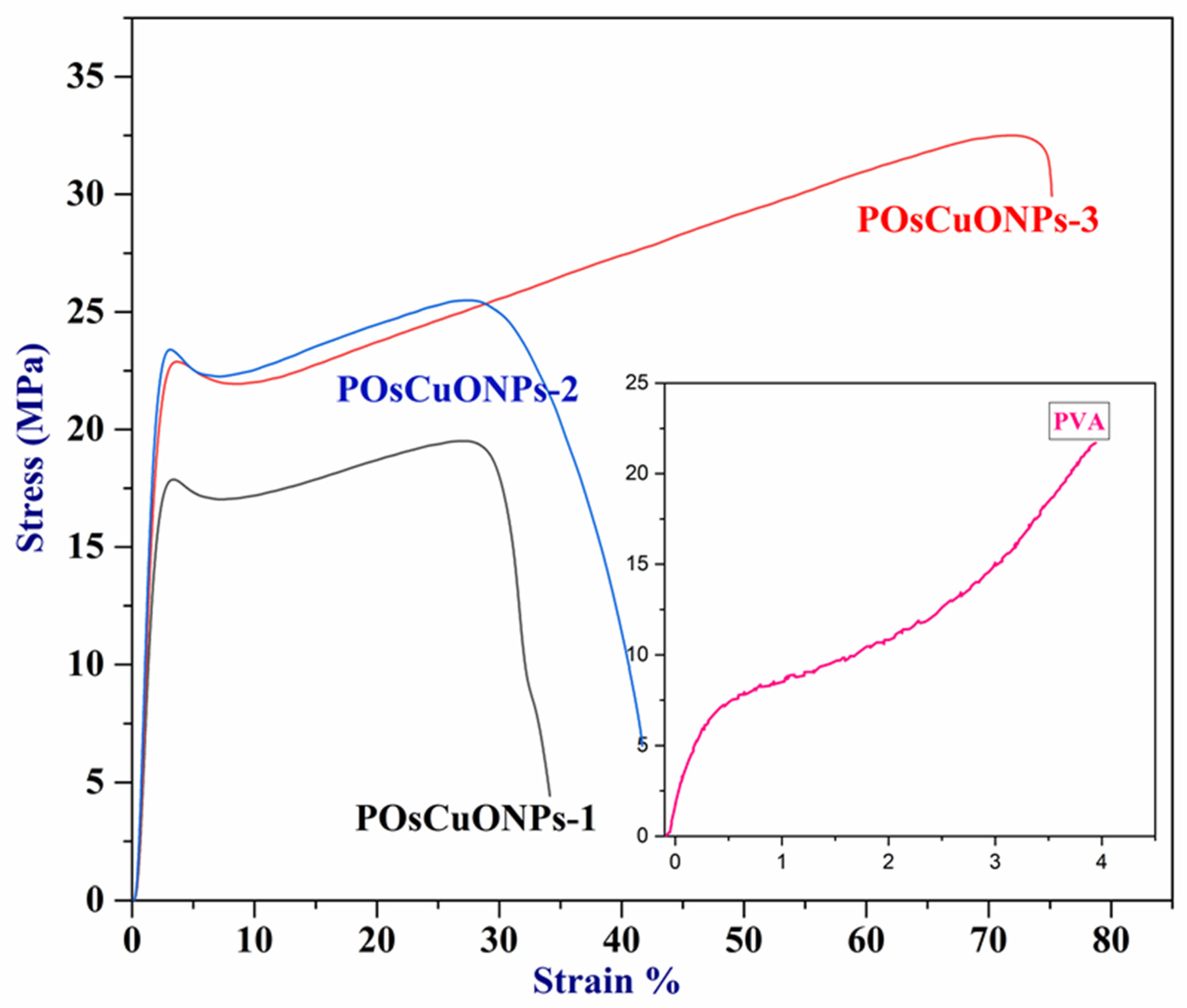


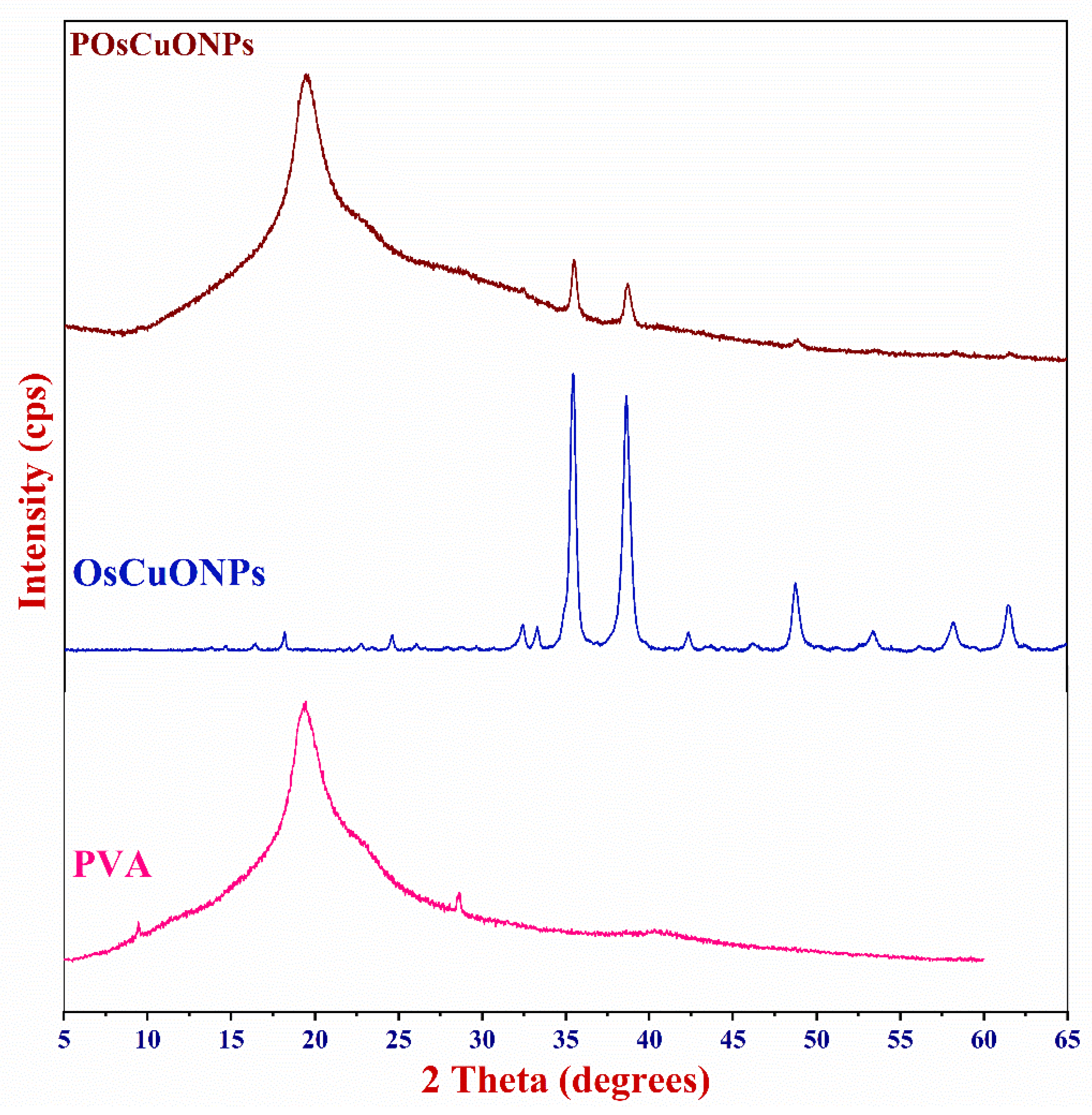

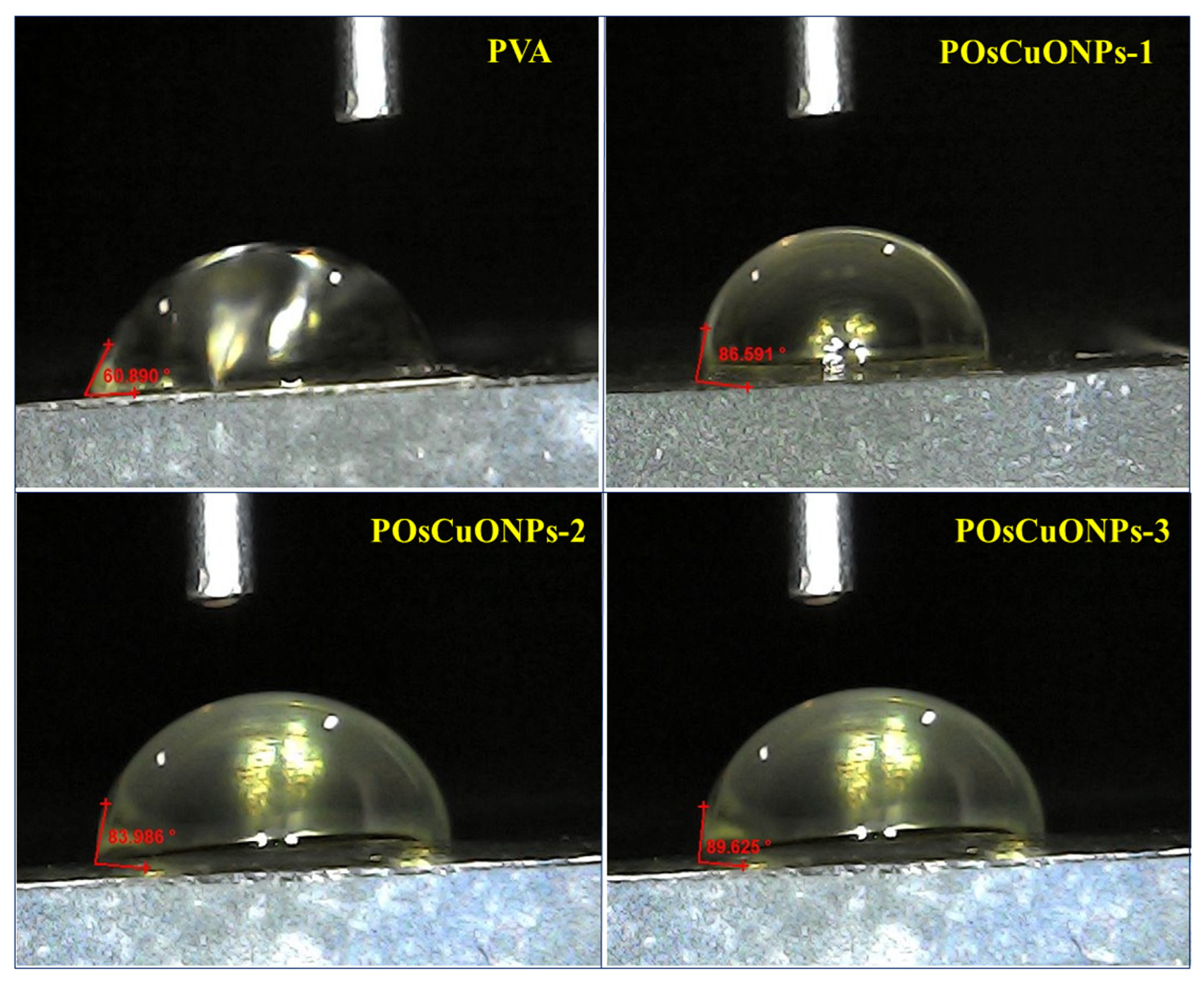
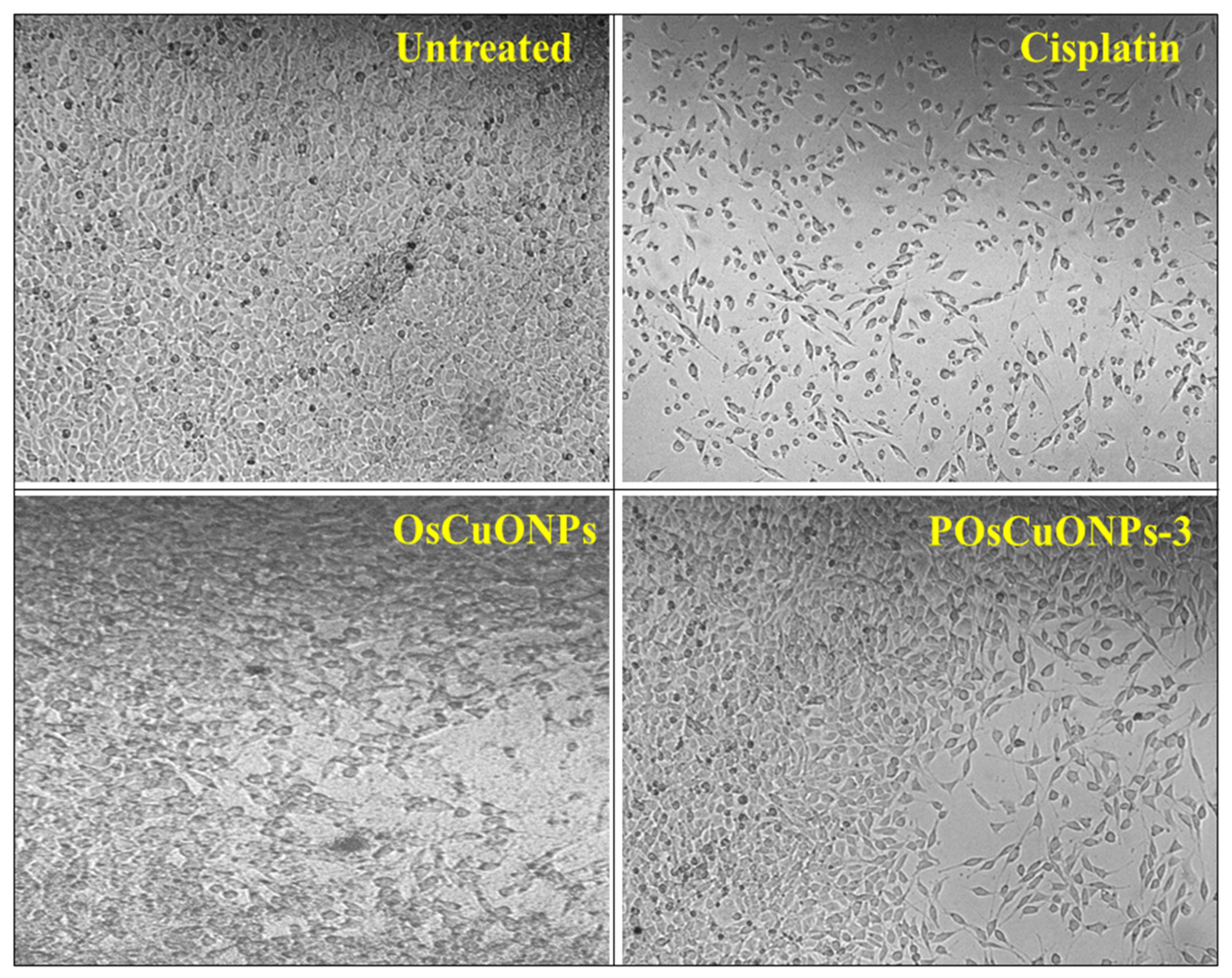
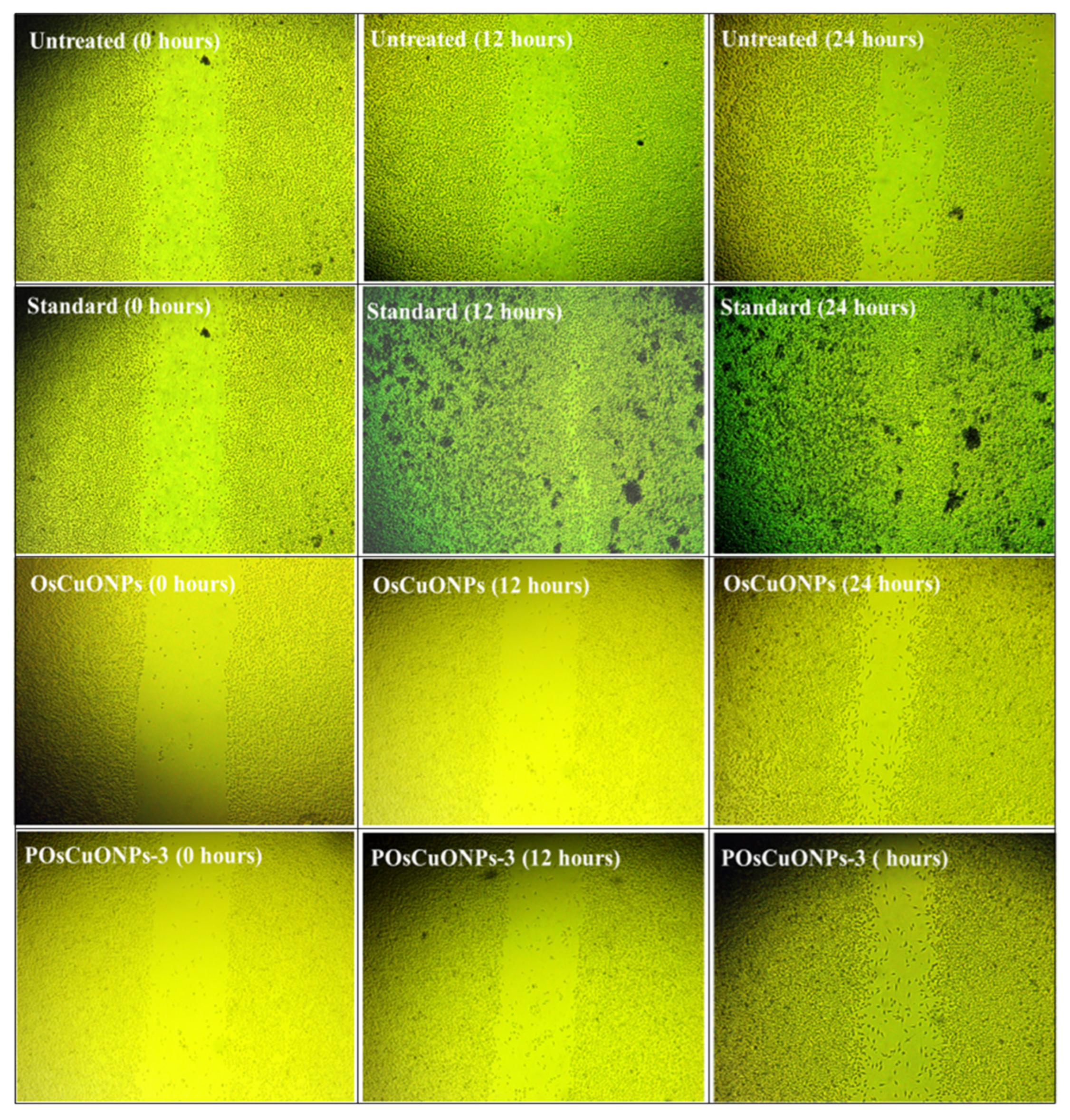
| Sample Code | PVA (g) | OsCuONPs (g) |
|---|---|---|
| PVA | 2 | 0 |
| POsCuONP-1 | 1.98 | 0.02 |
| POsCuONP-2 | 1.96 | 0.04 |
| POsCuONP-3 | 1.94 | 0.06 |
| Sample Code | Thickness (mm) | Tensile Strength (Ts) in MPa | Young’s Modulus (Ym) in MPa | Elongation at Break (%) |
|---|---|---|---|---|
| PVA | 0.09 | 21.705 | 24.483 | 394.327 |
| POsCuONPs-1 | 0.06 | 22.268 | 827.684 | 34.139 |
| POsCuONPs-2 | 0.05 | 25.493 | 1032.642 | 41.714 |
| POsCuONPs-3 | 0.07 | 32.502 | 1128.362 | 75.168 |
| Sample Name | L929 Cell Line ** IC50 (in µg/mL) 24 h |
|---|---|
| Untreated | 100 |
| Cisplatin | 10.21 |
| CuONPs | 58.34 |
| POsCuONPs-3 | 66.65 |
| Sl. No. | Samples | % Haemolysis |
|---|---|---|
| 1 | OsCuONPs | 25.72 ± 0.1078 |
| 2 | POsCuONPs-3 | 30.02 ± 0.0904 |
| Sl. No. | Samples | Duration in h | Cell Migration in µm |
|---|---|---|---|
| 1 | Untreated | 12 | 6.70 |
| 24 | 5.45 | ||
| 2 | Standard Ascorbic acid (5 µg) | 12 | 45.40 |
| 24 | 22.10 | ||
| 3 | OsCuONPs (15 µg) | 12 | 13.17 |
| 24 | 19.26 | ||
| 4 | POsCuONPs-3 (15 µg) | 12 | 12.53 |
| 24 | 20.60 |
| Sl. No. | Samples | Percentage of Wound Closure (%) |
|---|---|---|
| 1 | Untreated | 22.80 |
| 2 | Standard Ascorbic acid (5 µg) | 93.40 |
| 3 | OsCuONPs (15 µg) | 42.93 |
| 4 | POsCuONPs-3 (15 µg) | 47.19 |
Disclaimer/Publisher’s Note: The statements, opinions and data contained in all publications are solely those of the individual author(s) and contributor(s) and not of MDPI and/or the editor(s). MDPI and/or the editor(s) disclaim responsibility for any injury to people or property resulting from any ideas, methods, instructions or products referred to in the content. |
© 2025 by the authors. Licensee MDPI, Basel, Switzerland. This article is an open access article distributed under the terms and conditions of the Creative Commons Attribution (CC BY) license (https://creativecommons.org/licenses/by/4.0/).
Share and Cite
Pattadakal, S.; Ghatti, V.; Chapi, S.; G., V.; Kumarswamy, Y.K.; Raghu, M.S.; T., V.G.; Nandihalli, N.; Kasai, D.R. Poly(vinyl alcohol) Nanocomposites Reinforced with CuO Nanoparticles Extracted by Ocimum sanctum: Evaluation of Wound-Healing Applications. Polymers 2025, 17, 400. https://doi.org/10.3390/polym17030400
Pattadakal S, Ghatti V, Chapi S, G. V, Kumarswamy YK, Raghu MS, T. VG, Nandihalli N, Kasai DR. Poly(vinyl alcohol) Nanocomposites Reinforced with CuO Nanoparticles Extracted by Ocimum sanctum: Evaluation of Wound-Healing Applications. Polymers. 2025; 17(3):400. https://doi.org/10.3390/polym17030400
Chicago/Turabian StylePattadakal, Shrishail, Vanita Ghatti, Sharanappa Chapi, Vidya G., Yogesh Kumar Kumarswamy, M. S. Raghu, Vidyavathi G. T., Nagaraj Nandihalli, and Deepak R. Kasai. 2025. "Poly(vinyl alcohol) Nanocomposites Reinforced with CuO Nanoparticles Extracted by Ocimum sanctum: Evaluation of Wound-Healing Applications" Polymers 17, no. 3: 400. https://doi.org/10.3390/polym17030400
APA StylePattadakal, S., Ghatti, V., Chapi, S., G., V., Kumarswamy, Y. K., Raghu, M. S., T., V. G., Nandihalli, N., & Kasai, D. R. (2025). Poly(vinyl alcohol) Nanocomposites Reinforced with CuO Nanoparticles Extracted by Ocimum sanctum: Evaluation of Wound-Healing Applications. Polymers, 17(3), 400. https://doi.org/10.3390/polym17030400






